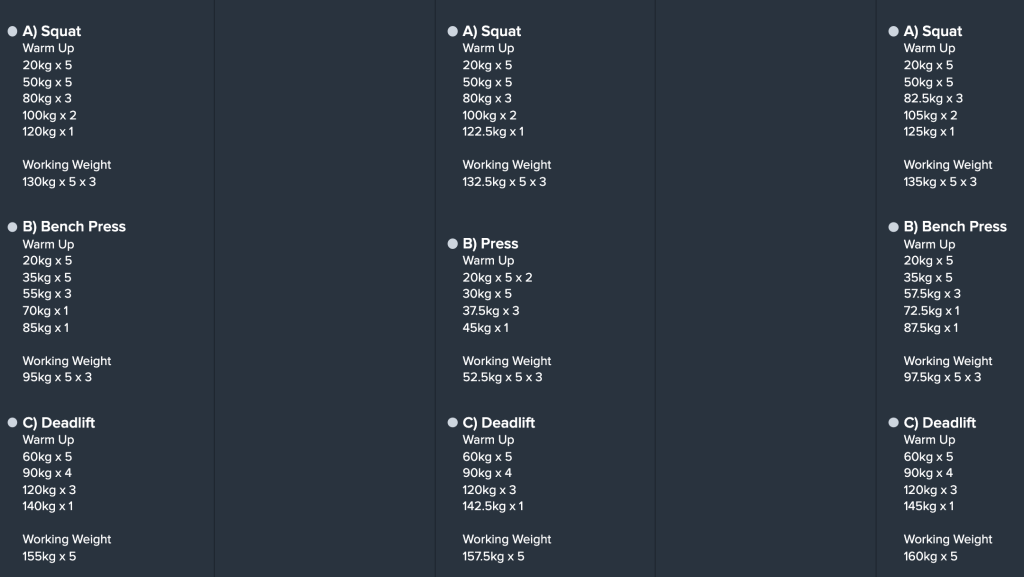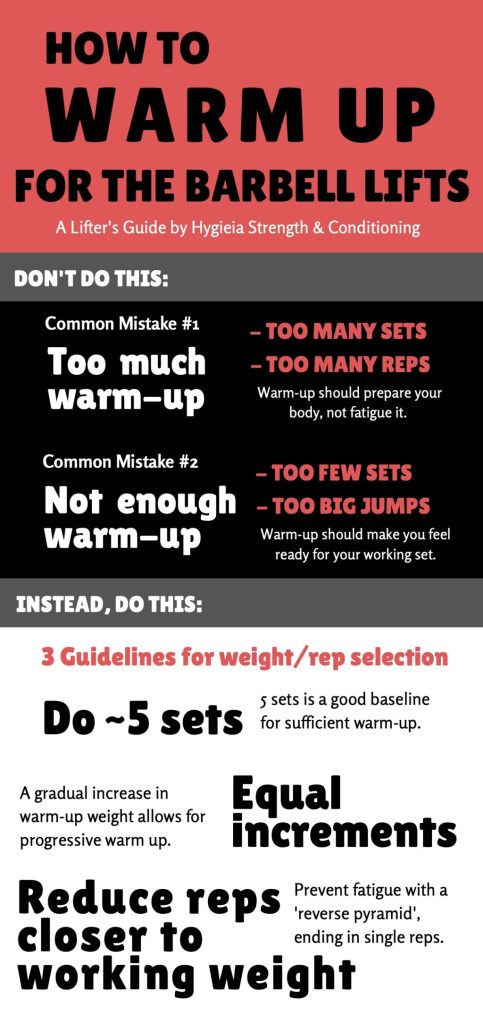Most of us have a clear training routine. You know that you’ll walk into the gym, change into lifting clothes, put on lifting gear and head to the rack. You know that you’ll start your training with squats, and you know the exact numbers for your working weight, sets and reps.
But what about your warm-up weights? And how many sets or reps? Actually, how much warm-ups do you even need to do?
In this article, you’ll find out how you should design your warm-up routine to get the most out of your training session.
Warm-ups are necessary to prepare your body for your workout
Warm-ups are an integral part of your workout. You need to do them properly, to prepare your body for your actual working sets.
It’s a bad idea to skip your warm-up and go straight into your working set. Even if you’re an experienced lifter, warm-ups are essential.
Don’t feel like you have the time to warm up? Want to skip the warm-ups and go straight to your working sets? Well, then you probably don’t actually have enough time to train – yes, warm-ups are that important.
No fancy moves needed: the best warm-up is the lift itself
Effective warm-ups have 2 components: they prepare your muscular tissue by raising its temperature, and also establish the movement pattern that you’ll be performing.
Because of this, the best warm-up for a barbell lift is the lift itself, just at a lower intensity.
How about “mobilising”, foam rolling or other fancy warm-up routines? The truth is, you don’t need them. They’re a waste of time, because they don’t improve your performance nor do they prevent injuries. If you enjoy them, and don’t mind spending the time, go ahead and do them – there’s no harm. Just don’t expect them to help with your training.
With that being said, there are situations where a general warm-up (not a specific barbell warm-up) can be useful. For example, our gym has loads of older guys with pretty inflexible shoulders, who like to do shoulder stretches prior to getting under the bar for their first warm-up set of squats.
But they only do this for a few minutes before starting their proper warm-up sets. Because the warm-up set is the same movement pattern as the working set, over time their tight shoulders will stretch out in the desired direction and feel better.
There are a few mistakes that we commonly observe lifters making when it comes to warming up. Let’s take a look at these common mistakes and see if you’re doing them yourself.
Mistake #1: Too much warm-up – you’re tired before you start
This happens when
- you do too many warm-up sets, and/or
- you do too many reps per set (often too close to your working weight)
Warm-up sets should prepare you for the working set, but not fatigue you.
New lifters often make this mistake. Maybe they’re nervous, because the working weight just looks too big. They’re not sure they can lift it. So they try to “feel” the weight by building up slowly and gaining confidence.
Here are typical mistakes, for a lifter warming up to a working weight of 100kg.
Example: too many warm-up sets
20kg x 5
30kg x 5
40kg x 5
50kg x 5
60kg x 5
70kg x 5
80kg x 5
90kg x 5
100kg (working weight)
Example: too many reps per set
20kg x 10
40kg x 10
60kg x 8
80kg x 6
90kg x 4 (too many reps too close to working weight)
100kg (working weight)
At this point, you’re probably a bit fatigued. You’ve spent too much energy on the warm-up. Energy wasted that could have been better used on your working sets – the sets that actually matter.
Do not fatigue yourself even before you start. It’s unnecessary and detrimental to your working sets.
Mistake #2: Not enough warm-up – you don’t feel ready
This looks like
- you do too few warm-up sets, and/or
- you make big jumps between sets
Your warm-up should make you feel ready for the working set.
Various lifters do this, because they feel that they don’t have enough time and need to rush. Or, they’re just impatient and want fast progress, so they speed through warm-ups to get to the working set.
Here’s what an insufficient warm-up routine looks like, for a lifter with a working weight of 140kg.
Example: too few sets, with large increments
20kg x 5
80kg x 5
140kg (working weight)
Taking such big jumps will not warm you up enough. You might think you’re ready, but you probably aren’t. And it’ll show, during your working set. It’s very likely that when you unrack the bar on your work set with too few warm-up sets, the weight will feel immensely heavy on your back. That jarring feeling of unracking a heavier than expected weight may even adversely affect your confidence of completing the set.
If time is really limited, here’s how you can speed up your workout without compromising your warm-ups.
Is there a formula for the ideal warm-up programme?
Short answer: no.
You might have seen websites or apps where you punch in your working weight and it outputs a full programme of warm-up weights and reps. Some lifters will mindlessly follow whatever numbers are shown, but I don’t recommend it.
Because it’s important that you actually understand the principles and thinking behind warm-up weight/rep selections.
Also, these automated selections aren’t tailored to individuals. They’re based off a simple percentage of your working weight. Some lifters prefer higher reps for fewer warm-up sets; some prefer their last warm-up set to be quite close to their working set. It really depends on the lifter.
While there’s no ideal programme, here are 3 guidelines for how to select the weights, reps and sets that will work best for you.
You’ll need to know your working weight, and the weight of the bar. Let’s assume a standard 20kg barbell, and we’ll refer to that as the empty bar.
Warm-up guideline #1: Do about 5 sets of warm-ups
When in doubt, 5 warm-up sets is a good baseline to start from.
Of course, your actual number of sets may increase or decrease depending on your condition, working weight, or your training plan for the day.
If you’re stiffer – due to prior injury, age, if you train first thing in the morning or live in a cold country – you could do with more warm-up sets, or higher reps with an empty bar for the first increment.
Otherwise, 5 is a number that’ll work for most people.
Example: 5 sets, for a working weight of 140kg
Warm-up set 1: 20kg x 10, or 20kg x 5 x 2 (empty bar)
Warm-up set 2: 45kg x 5
Warm-up set 3: 70kg x 5
Warm-up set 4: 95kg x 3
Warm-up set 5: 120kg x 1
Working set: 140kg (working weight)
Warm-up guideline #2: Make relatively equal increments in weight
Here’s why you need to know your working weight and starting weight – so that you can calculate increments that aren’t too big or too small. This allows you to warm up progressively.
First, find the difference between the two weights. For a 140kg working weight and a 20kg starting weight (the empty bar), the difference is 120kg.
Next, divide that number by 5, to get 25kg. This will be your ideal increment for the 5 sets.
Example: relatively equal increments
Warm-up set 1: 20kg (empty bar)
Warm-up set 2: 45kg
Warm-up set 3: 70kg
Warm-up set 4: 95kg
Warm-up set 4: 120kg
Working set: 140kg (working weight)
Exceptions: You might prefer your last warm-up to be closer to your working weight, to reduce any feeling of “oh damn, that’s heavier than expected” when you finally unrack your working weight.
In this case, you can adjust the increments so that your last warm up set to be 130kg x 1. Generally, your last warm-up weight should be around 5-10% less than your working weight.
Warm-up guideline #3: Reduce reps closer to your working weight
One of the best ways to prevent fatigue is to decrease the number of reps as you get closer to working weight. You’re aiming for a reverse pyramid.
Example: reducing reps, for a working weight of 140kg
Warm-up set 1: 20kg x 5 (empty bar)
Warm-up set 2: 60kg x 5
Warm-up set 3: 80kg x 3
Warm-up set 4: 100kg x 2
Warm-up set 5: 120kg x 1
Working set: 140kg (working weight)
Exceptions: if you’re sore, or have stiff joints, or just don’t “feel” the groove that day, you can do more than 5 warm-up sets, or more reps – just keep in mind to not overdo it and unnecessarily fatigue yourself.
Especially if you’re lifting big numbers, aiming for a PR or preparing for a meet attempt, you might want to do more warm-up sets for singles.
Example: reducing reps, for a bigger working weight e.g. 300kg
Warm-up set 1: 20kg x 5 (empty bar)
Warm-up set 2: 70kg x 5
Warm-up set 3: 120kg x 3
Warm-up set 4: 170kg x 1
Warm-up set 5: 220kg x 1
Warm-up set 6: 260kg x 1
Warm-up set 7: 280kg x 1
Working set: 300kg (working weight/PR or meet attempt)
Choose the warm-up protocol that works best for you
While useful, these tips are just general guidelines. They aren’t rules set in stone.
Because every lifter is different, and your body also changes day by day, you need to understand how to choose your best warm-up protocol based on your needs on that particular training day.
Don’t lock yourself into a rigid programme. Look out for those common mistakes, but also experiment with the guidelines above, pay attention to how you feel, and be prepared to adapt as you go along.
If you find that you can’t quite remember the guidelines or what to avoid at your next training session, here’s a handy summarised infographic.



